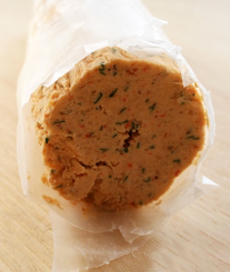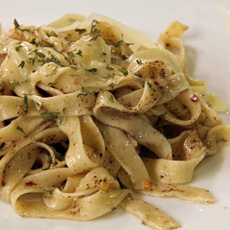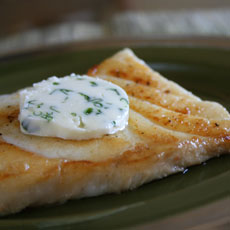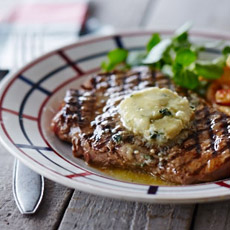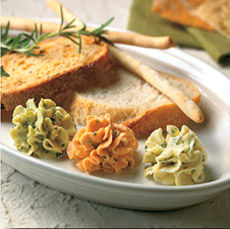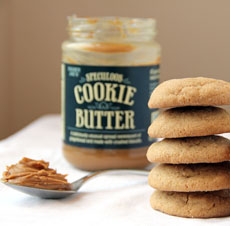TIP OF THE DAY: Compound Butter Enhances Any Recipe That Uses Butter
|
Want to become a more impressive cook instantly? Use compound butter! Also known as finishing butter, or beurre composé in French, it’s unsalted butter that has been blended with seasonings. There are endless variations. Escoffier published 35 combinations in 1903, and cuisine has evolved in many directions since his classic renderings of anchovy butter and beurre à la maître d’hotel (lemon parsley butter). In Continental cuisine, compound butter is added to the pan to finish a sauce; a pat is placed directly atop meat, fish, potatoes or other vegetables to melt into a self-sauce; or is mixed into pasta and rice instead of other sauces/garnishes. Just a dab transforms a dish: If you think butter makes everything taste better, think of what butter infused with great seasonings will do. Compound butters are an easy alternative to more complex sauces. Make them ahead of time and keep them in the freezer, slicing off a pat as needed. They are a highly flavorful complement to the main ingredient. Herb butter (most often served atop steak), Roquefort butter (ditto) and anchovy butter (a classic with grilled seafood) are staples at fine steakhouses. Read a French restaurant menu and maître d’hôtel butter (lemon parsley) is certain to be garnishing some dish. And that delicious sauce served with escargots? A compound butter of lemon juice, parsley and garlic. If you go out to nice brunch places, you may have had strawberry butter too: fresh strawberries blended into softened butter. The recipe for all flavored butters is the same: All compound butters can be used as bread spreads. But here’s just a small sample of flavor combinations: Here is our collection of compound butter recipes: Perk up your cuisine with these compound butters. For each of the flavorful suggestions below, simply take your favorite Butter of Europe and let it soften to room temperature over a few hours. Once softened, blend with the ingredients of your choice in a bowl. Once thoroughly blended, place the compound butter in a mold or on a piece of wax paper to be rolled into a log. Then chill until ready to serve. It’s that easy! If you’re in need of an introduction to compound butters, look no further. Just add finely minced parsley, lemon juice, salt and pepper to the softened butter, and voilà! This classic French recipe can be used on everything from finishing baked fish or an oven roasted chicken to simply adding a zippy twist to a parker house roll. If you want the full French experience, add a pat to a seared steak. It will melt to create a sauce. There are few combinations more popular than butter and garlic. The list of foods that both garlic and butter belong on is seemingly endless, which is why this creation belongs in your refrigerator for frequent use. Add a touch of chive, to impart some green herbal character. It’s just the thing to add a layer of complexity to a classic combo. Place directly on a grilled steak or drop a pat or two into a steaming baked potato. Or, treat the family to garlic bread! Prefer a tad more citrus? Swap in a lemon for a touch more mouth puckering flavor. Want to turn the heat up a bit? Experiment with other chile peppers that climb the Scoville scale, like Habanero. Brush over grilled or boiled corn on the cob or grilled shrimp for a bright and delightful flavor addition. There’s a reason cheese plates are often presented with a bit of honey. The salty, creamy texture of blue cheese pairs so well with the floral sweetness of honey. This compound brings those two together, encasing them in butter for an extra dose of deliciousness. Try this melted on a pork loin or chop or tossed with your favorite pasta. Serve a sweet compound butter with cornbread, muffins, oatmeal, pancakes, sweet potatoes, and of course, a simple piece of toast. All of these foods are made that much better when you top them with butter. Start with a touch of your favorite maple syrup. Next, we’d recommend a fresh vanilla bean, for not only its purity of flavor, but for the flecks of vanilla bean that have eye appeal as well. |
|
|
|
ABOUT THE BUTTER OF EUROPE Specialty butter like compound butter is a growing category. The Butter of Europe Marketing Campaign, orchestrated by CNIEL (The French Dairy Inter-Branch Organization) and co-funded by the European Union, was designed to create awareness for the variety of European butters available in the U.S. market, and to suggest ways that Americans can incorporate butter into their recipes. Visit @ButterofEurope on Instagram and Facebook. European-style butter refers to a cultured* butter that has been churned longer to achieve at least 82% butterfat (the EU minimum standard). The American standard is 80% butterfact. The extra fat makes the butter more spreadable. In baking, it makes for flakier pastries. In the U.S., you’ll come across: In the U.S., you’ll come across: European-style butters are becoming so popular that U.S. brands like Land ‘O’ Lakes are making their own European-style butters.the EU standard). Plugra is the most widely distributed, but also look for regional butters from Vermont Creamery, Kriemhild Dairy Farms, McClelland’s Dairy and other fine dairies. *Cultured butter is made from fermented cream—fermented with bacteria cultures. During the fermentation process, the bacteria convert milk sugars into lactic acid. The fermentation process produces additional aroma compounds, including diacetyl, which makes for a fuller-flavored, tangy, and more “buttery” tasting product.
|
||
